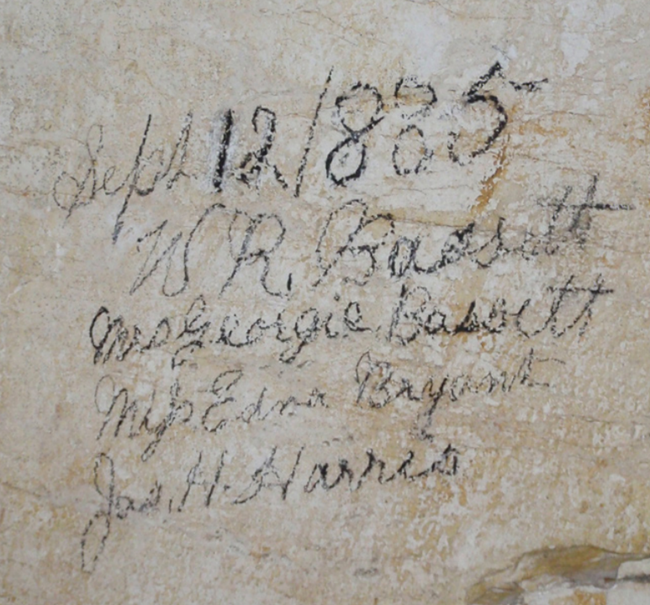Part of a series of articles titled The Midden - Great Basin National Park: Vol. 15, No. 2, Winter 2015.
Article
Stories of Early Lehman Cave Visitors
This article was originally published in The Midden – Great Basin National Park: Vol. 15, No. 2, Winter 2015.

NPS Photo by Gretchen Baker
Editor’s note: Part 1 of this story, Sign In: The Writing on the Wall appeared in the Summer 2015 issue of The Midden.
Nearly 2200 signatures and initials in Lehman Cave have been photographed and recorded to date. Many of the signatures are duplicates, marking repeated visits by the individual(s) or various locations visited during the same trip. For instance, William R. Bassett’s name or initials have been recorded 14 times. His first visit to the cave appears to be on September 12, 1885, within five months of the exploration of the cave. At that time, he was accompanied by his wife, Georgie, his stepdaughter, Miss Edna Bryant, and James H. Harris (who owned the Capital Saloon in Ely by 1890). A year later, Miss Bryant married J.B. Simpson, a deputy sheriff, livery stable owner, and mine investor. The young couple then honeymooned at Lehman Cave and she signed her name as Mrs. Edna Bryant (her husband’s name does not appear to be part of the cave record).
Let’s take a closer look at the lives of some of the early visitors of Lehman Cave. William R. Bassett and Mrs. W. R. Bassett were the head of the Bassett family who lived in Steptoe Valley, White Pine County in 1885. Mr. Bassett is first mentioned as a gambler, owning a saloon and racetrack in the mining town of Ward, NV. His card games attracted people from Cherry Creek, Hamilton, and Eureka, NV, and when the game finally ended the ground out in front of his saloon would be covered with playing cards. He was elected on the Republican ticket as sheriff of White Pine County in 1884. By 1885, he owned a livery stable in Taylor, NV and soon opened a restaurant in Ward. In the summer of 1887, he opened a new saloon in Ely with a Bengal Tiger on display to attract customers. Bassett was re-elected sheriff in 1888. During this period, the Bassett family was apparently doing quite well, as William Bassett was assessed $3,580 on real estate in 1889. The last time the Bassett name appeared in the cave with a date associated with it was in 1918.
Edwin W. Clay, a contemporary of the Bassetts, is also well documented both inside and outside of the cave. His surname appears at least 30 times inside Lehman Cave. Clay, along with those previously mentioned, lays claim to being one of the first explorers of the cave. E. W. Clay first came into the Snake Valley region with horses that he had purchased in California to sell to the local ranchers. He stayed in the area and eventually married Margaret “Maggie” Burbank in 1884.

Photo by David Harwood
‘. . . the seven of us had only three candles to light our way. We also had our pockets full of pieces of charcoal and as we walked along we would stop every little ways and mark on the walls of the cave with charcoal an arrow, which pointed to the opening of the cave. This was to be our guide in getting out of the cave. Finally we came to a round hole just large enough for us to crawl through, with the exception of Ab Lehman and he was too fat, he couldn’t make it, so had to sit and wait nearby for us to return. Well, we five men and this boy entered this hole; it was like crawling through a tunnel. As we entered the open space there was sort of a shelf above us. We explored around for about one mile. There were beautiful sights of staghtites (sic) and Stahgelmite (sic), but when we tried to return to where Abs (sic) Lehman was we found ourselves lost. It was impossible, try as we may, to find the hold (sic) by which we entered. We groped around, hunted and hunted, but no hole was in sight; finally we decided we had better just burn one candle at a time in order to conserve our light, as it was sure dark in there. One said, “Well, Lehman is near the entrance and he will surely help us to get out of here.” While we were sitting on the ledges debating and wondering what our fate would be, Ed Lake, the then 10 year old boy was peeping around a little and happened to see the hole by which we entered. Well, I thought we would knock that wall down trying to all crawl through that hole at once...We were in that cave 7 hours, lost most of the time.”
Edwin and Maggie Clay had four children, sons named Leslie, Burton, Clarence “Stanley,” and Edwin junior. All four of the children names appear in the cave, but no dates are recorded near them. We know that Edwin Jr.’s name was recorded prior to 1907 because he drowned in Lake Creek Reservoir in that year. Likewise, his brother Stanley died a few years later, trampled while herding horses. Times were not easy on the Clays either inside or outside the cave.
There are many stories yet to be told of the visitors to Lehman Caves. They include tales of murder, horse thieves, adultery, WWII espionage, and more, but in truth, most visitors lived out their lives as ranchers, farmers, doctors, pharmacists, miners, shop keepers, saloon owners, etc. The stories behind the names in the cave are the stories both of people who came and went from White Pine County and those who stayed and whose descendants are still living in the surrounding towns in Nevada and Utah.
Last updated: March 20, 2024
